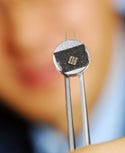July 1, 2007
R&D DIGEST
|
A prototype direct-current nanogenerator fabricated using an array of zinc oxide nanowires. Photo by Gary Meek. |
A protoype of a nanometer-scale generator can produce continuous direct current electricity by borrowing energy from its environment. Researchers from the Georgia Institute of Technology, led by Zhong Lin Wang, Regents' professor in the School of Materials Science and Engineering, created the device.
This prototype is a few steps ahead of a previous iteration for several reasons. For one, the new version is made from vertically aligned zinc oxide. The material is piezoelectric and semiconductive, as well as nontoxic and biocompatible. Earlier versions used platinum-coated silicon. Also, the vertical alignment promotes movement inside a zig-zag plate electrode, enabling several nanowires to harvest power at once, rather than one at a time, as in the original design.
The protoype was made by first growing an array of vertically aligned nanowires approximately a half-micron apart on gallium arsenide, sapphire, or a flexible polymer substrate. A layer of zinc oxide was grown on top of substrate to collect the current. The researchers also fabricated the silicon zig-zag electrodes, which contain thousands of nanometer-scale tips made conductive by a platinum coating.
The electrode was then lowered onto the nanowire array, leaving enough space so that some nanowires were free to flex within the gaps created by the tips. Moved by mechanical energy such as waves or vibration, the nanowires periodically contact the tips, transferring electrical charges. By capturing the tiny amounts of current produced by hundreds of nanowires kept in motion, the generators produce a direct current output in the nanoampere range.
Wang and his group expect that with optimization, their nanogenerator could produce as much as 4 W/cm3, based on a calculation for a single nanowire. That would be enough to power biosensors implanted in the body.
The research was sponsored by the Defense Advanced Research Projects Agency, the National Science Foundation, and the Emory-Georgia Tech Center of Cancer Nanotechnology Excellence. Details of the nanogenerator were reported in the April 6 issue of the journal Science.
Copyright ©2007 Medical Device & Diagnostic Industry
About the Author(s)
You May Also Like


.png?width=300&auto=webp&quality=80&disable=upscale)
